In October, Graciete Batalha's study of the Macanese dialect, Glossário do Dialecto Macaense, first published in 1967, was re-edited. This second edition is particularly valuable, as the first has been unavailable for many years and the book is an important contribution to understanding Macau's patois. The new edition has a supplement, Suplemento ao Glossário do Dialecto Macaense, in which the author presents "terms which escaped the first edition" although she also recognises the fact that "a linguistic study can never be definitive" and that it will never be as exhaustive as one would wish.
The author also mentions that when the first edition came out, important sources of patois such as Ana Maria Amaro's Jogos Populares de Macau and works by José dos Santos Ferreira had still not been published. Bearing in mind that a work of this nature will always cry out for appendices, her book still constitutes a valuable contribution to the future of "a doci lingua di Macau" (Macau's sweet tongue).
The next book to appear was in November, although it had already been prepared sometime beforehand. This was the Jesuit Father Benjamim Videira Pires' Os Extremos Conciliamse.
This book is a rigorous study produced by a man with a tremendous experience, who has a deep understanding of literature, philosophy and history. The book has still not been awarded the acclaim it deserves. It is a work on Portuguese cultural history which goes beyond the frontiers of Macau as a cultural entrepôt, into the sphere of world history in general. It is increasingly rare to find books of this kind dealing with world, or even Portuguese history. Father Pires claims that it was the cultural contacts which opened the way and enabled the ensuing economic contacts to be made.
There is a wide range of topics, information and understanding to be drawn from the lengthy relations between China and Portugal in which Macau formed the middle link. The book provides definitive proof of the cultural symbiosis created over the span of four centuries, as the author claims in his preface:
"Miscegenation, assimilation, acculturation, none of these can be be clearly defined by anthropological studies. This continued process of cultural osmosis affecting all that we are and have is, in fact, a synthetic experience which has been produced by this period of Luso-Chinese history. We have the meeting of two opulent cultures - Chinese and Portuguese- which jointly created a new culture here in Macau.
Father Manuel Teixeira's comment on the book was that it "marks a step forward in Macau's historiography. It is an enormous step which has particular relevance for Macau's cultural environment as it provides an encyclopaedic sourcebook for matters related to the territory. This conscious attempt at reinforcing Macau's collective identity is a must for anyone working in the field of culture and is surely worth translating into Chinese.
Instrução para o Bispo de Pequim e Outros Documentos para a História de Macau by Dr. Manuel Múrias was reprinted in December by the Publishing Department.
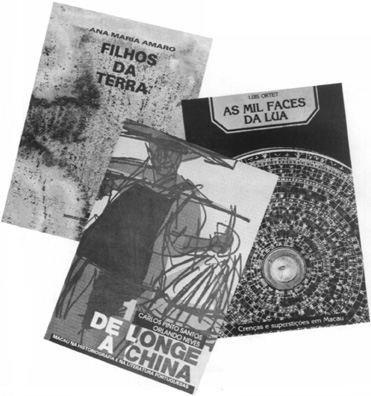
Father Manuel Teixeira's comments on the book are as follow: "This book has a place on the bookshelves of every scholar interested in Macau. It sheds new light on Portugal's relationship with China and marks a step for ward for Macau's own history. The text lay forgotten in the Colonial Historical Archives until 1943, when Manuel Múrias, director of the Archives, brought it to the attention of the world. It is to be hoped that the manuscript by the Jesuit, Father Montanha, entitled "Notes on the History of Macau's Bishopric" is published. Manuel Múrias started to publish it in the paper A Voz but never managed to finish it. Another work worth publishing is the manuscript "Pontos que me Alembro", a collection of interesting notes concerning Macau's history by an anonymous Jesuit.
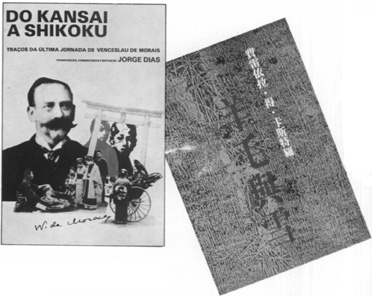
In his preface, Manuel Múrias gives a brief explanation of the book's contents: "This volume contains material related to two documents which are fundamental to the history of the Portuguese presence in Macau and Portugal's relations with China:
1 - The instructions which the Bishop of Peking, D. Frei Alexandre de Gouveia, carried with him. Some of them were given to him in Lisbon, others were from the Governor and Captain General of India, D. Frederico Guilherme de Sousa;
2 - The Legal Charter and Regulations of the Custom-House of the City of Macau.
These contemporary documents are a reflection of the interest at that time in establishing Portuguese bases along the Chinese coast, an interest which was grounded on both economic and missionary motives.
After the expulsion and dissolution of the Society of Jesus, Portuguese influence in China decreased considerably. The missions which the priests had founded and maintained fell into disuse and disappeared. With the decline in religious influence, political influence became greater and China's interest in the old Portuguese settlement became stronger.
At the same time, the Naval and Overseas Ministry, directed by Martinho de Melo e Castro, was attempting to recuperate the position of the Portuguese dioceses in China and the economic importance of Macau and its dependent territories. To this effect, a new bishop was elected to the diocese of Peking and Macau's administration was reorganised, with the creation of a Custom-house.
Historians were familiar with the Regulations of the Custom-house. The instructions which the Bishop of Peking took with him were known to exist, but up to this point they had not been seen although a few historians in Macau still mentioned them frequently.
Of course, this is not a book which will be widely read but I trust the documents which I now bring to light will be of use to those researching Oriental history." This book is invaluable in view of the present cultural policies in effect, policies which promote the recuperation of a history which has stretched for over four centuries.
In memory of the fourth centenary of the introduction of movable type presses in the Orient, ICM published a facsimile edition of the first book to be printed in Macau using the Gutenburg technique. The press was brought to the Far East by the Jesuit Father Alexander Valignano and was put into use in Macau in 1588, during a stop-over on the way to its ultimate destination -Japan. The book in question is Father Johannes Bonifacio's Christiani Pueri Institutio Adolescentiaeque Perfugium. The new edition was produced from the only known existing copy, held in the Ajuda Library and has a preface by Manuel Cadafaz de Matos.
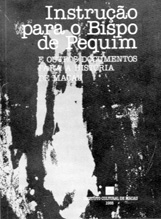
Number 5 of the Revista de Cultura (Portuguese edition) came out in December along with the first volume in a series of monographs entitled Opúsculos. This first volume is an offprint of Graciete Batalha's study on the toponomy of Macau, "This Name Macau".
In the area of bilingual editions aimed at offering works by Portuguese authors to Chinese readers, Jorge de Sena's 0 Físico Prodigioso came off the press (Chinese translation by Jin Guo Ping).
Another book which came out in December was Os Filhos da Terra by Ana Maria Amaro.
"The social structure of the Macanese, the "filhos da terra" (sons of the earth) has unique characteristics which can only be revealed through an integrated study of the variables which affect its group identity. Who are the Macanese, from an anthropological or cultural point of view? How have they organized themselves and remained isolated for the four centuries of Macau's history? What kind of social and physical environment did this group have to adapt to and how did it manage to do this?"
With mental rigour and great sensitivity Ana Maria Amaro attempts to answer these questions. The book is divided into chapters dealing with history, anthropology, ethnography (patios, pet names, cooking, clothing, games and pastimes, handicrafts and so on) all of which make the Macanese a different group of people.
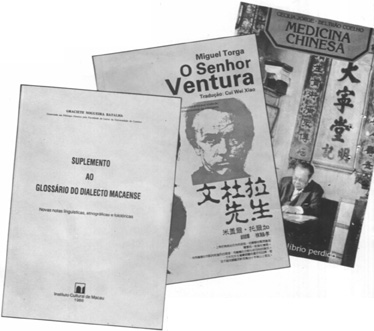
Two exquisite collections of postcards dealing with Macau's architectural heritage were printed with accompanying notes in Portuguese, Chinese and English. The photographs come from ICM's in-house archives and were taken by Eduardo Tomé and Álvaro Tavares.
ICM's Special Projects Department published three books in December, with the intention of sending them to Lisbon for the First Macau Book Fair in Portugal: De Longe à China (2 volumes), As Mil Faces da Lua and Medicina Chinesa.
De Longe à China - Macau na Historiografia e na Literatura Portuguesa is a collection of reference texts concerning Macau, written by Portuguese historians, writers and chroniclers from the XVIth century to the XIXth century and collated by Carlos Pinto Santos and Orlando Neves. The book is easy to consult and presents texts by around thirty five authors. Each author is presented with bio-bibliographical notes and accompanied by illustrations. Volume I has texts by Damião de Góis, Fernão Mendes Pinto, Camões, Leonel de Sousa, Manuel de Faria e Sousa, António Bocarro, António Francisco Cordeiro, António Fialho Ferreira, Conde da Ericeira, Charles Boxer, Francisco de Sousa, José de Jesus Maria, Francisco de Sampaio, Martinho de Mello e Castro, Bocage, José Inácio de Andrade, Visconde de Santarém, and Almeida Garrett. Volume II includes texts by Carvalho e Sousa, Alexandre Herculano, Carlos José Caldeira, José António Maia, Francisco Maria Bordalo, Andrade Corvo, Camilo Castelo Branco, Manuel de Castro Sampaio, Adolfo Loureiro, António Marques Pereira, Eça de Queirós, J. Gabriel Fernandes, Venceslau de Morais, Bento da França, Conde de Arnoso, Joaquim Calado Crespo.
As Mil Faces da Lua - Crenças e Superstições de Macau by Luís Ortet is a new volume in the "Traditions and Festivities" collection which started off with A Fénix e o Dragão by Cecília Jorge and Beltrão Coelho. This is a highly informative book with excellent graphics, intended for the general public. It focusses on the Chinese traditional sciences of divination and how they are used nowadays in Macau. The book is attractively presented and gives visitors or residents in Macau a very different view of the city, its urban structure, architecture, symbols and social customs.
The larger part of the book is devoted to Feng-Shui (wind and water) which is the traditional art of analysing the configurations of the earth in order to find the optimum orientation for attracting benevolent influences.
Next there are chapters on Astrology, Physiognomy, Palmistry, I Ching, and other methods for telling fortunes and superstitions. The book is generously supplied with illustrations and photographs.
The same general comments can be applied to Cecília Jorge and Beltrão Coelho's work Medicina Chinesa - Em Busca do Equilíbrio Perdido. According to the authors in their introduction, there has been no "widespread technical study directed at a Western audience on the merits and demerits of traditional Chinese medicine". Thus the book is intended to provoke "a reassessment of the Chinese way of being, by attempting to give the Portuguese a deeper understanding of a people with whom they have shared the space of Macau since the second half of the XVIth century. The book attempts to give a clear and simple explanation of the philosophical basis of Chinese medicine, the Chinese concept of health, the way in which traditional treatments work and the treatments which have been passed down to the present".
Particularly worth looking at are the chapters on "The Theory of the Cosmos and the Five Elements", "Yin and Yang", "Life Energy (Qi)", "The Traditional Classification of the Organs", "Acupuncture and Moxibustion", "Herbal Medicines" and "The Theory and Practice of Longevity". The text is accompanied by beautiful photographs taken by Lok Tai Tong.
During the first quarter of 1989, ICM published two books which will make a significant contribution to the learning of Portuguese by Chinese speakers: Lições de Português Elementar and the additional exercise book by Wang Zeng Yang, a Portuguese teacher in the University of Foreign Languages in Peking. These are the first two volumes in a series of eight books which will provide a basis for the learning of Portuguese in the future.
Do Kansai a Shikoku, a collection of correspondence by Venceslau de Morais, was published in March. The text was compiled with notes and a preface by Jorge Dias, a specialist on Morais. The letters in question were sent by Morais to his high school friend Carlos Campos and his daughter, Maria Joaquina Campos after the death of her father in 1912. There are over one hundred letters and postcards written between 1899 and 1928. They are held in the Library of the University of Foreign Studies in Kyoto. The book contains reproductions of postcards from Japan in the the early XXth century.
The next bilingual book to come off the press was O Senhor Ventura by Miguel Torga. The original version of this book has already been reviewed in the Review of Culture, Nō4, p.45 ("The Orient in Portuguese Literature" by Andrée Rocha): "We do not find here a China with which the author has previous acquaintance. The setting, however, is a paradigm or emblem of all the places to which the hero has been led by his adventurous spirit, exactly like those places with which so many Portuguese were confronted in the past and on which their creative imagination set to work. The translator, Cui Wei Xiao, guarantees the reader that this translation is honest, meticulous and loyal to the original sense of Torga's text.
A Lã e a Neve by Ferreira e Castro and translated by Lu Ping was the next book to be published in a bilingual edition.
A publication which will be of great interest to researchers and readers is the Boletim Bibliográfico de Macau (Monografias) Vol I Nō 1. This bibliography complements rather than serves as an update to Luís Gonzaga Gomes' Bibliografia Macaense (1973) which was reprinted last year in a facsimile edition.
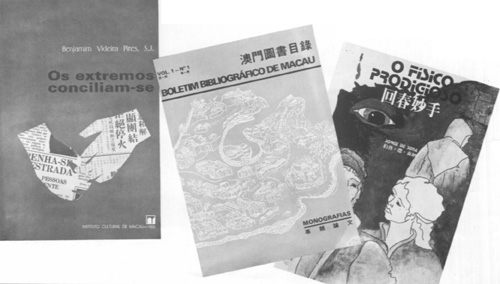
According to Jorge Arrimar, Director of the National Library, the purpose of the book is: "To publish,three times a year, a Bulletin for the reading public on each of the three series to be produced: 1 - Monographs, 2 - Periodicals, 3 - Legislation.
The Bulletins will start from the most recent year and go back to 1973, the point at which Luís Gonzaga Gomes completed his bibliography. There is no bibliographic material concerning what has been written in Macau during recent years. The first edition of the Bulletin will cover the period 1987 to 1982, and the second 1981 to 1973.
It is worth mentioning that this bibliography is not intended to provide information on all known material about Macau (unlike the case with the Bibliograifa Macaense), but rather give the reader information about the documents held in the National Library of Macau in conformance with internationally recognized bibliographical norms.
The Bulletin in basically divided into two parts: the first is composed of bibliographic references to monographs written in Portuguese (or other European languages) and held in the National Library. The second part is composed of references to monographs written in Chinese, held in the Sir Robert Ho Tung Library.
There are two indices, one organized by name, the other by topic, thus aiding the reader to follow up his or her personal field of research.
All the information contained in the Bulletin has been entered on computers which will provide the first step towards producing a Data Base on the Portuguese in the Orient, a project which the ICM hopes will serve as a support for scholars and researchers of Portuguese history in this region.
Last, but in no way the least to come off the press, was Guilherme Ung Vai Meng's moving album of drawings and photographs reflecting his journeys in Europe (Portugal, France, Spain, and England) and most of all his impressions of Macau, which come out as an over-riding theme. In the words of António Conceição Júnior, he "presents the positive aspects of a process of cultural mélange of which he undoubtedly in a representative". Mio Pang Fei states that he "offers us a pure space, showing an intense true love which radiates with sympathy.
Similarly, Carlos Marreiros is impressed with the work of this artist: "I am totally convinced of his talent when I turn over the pages of his drawings: they are complete, intelligent, moving and altogether well-executed."
This is to be the first in a series of volumes of works by Macau's artists, starting off with the artists who work in the ICM Publishing Department.
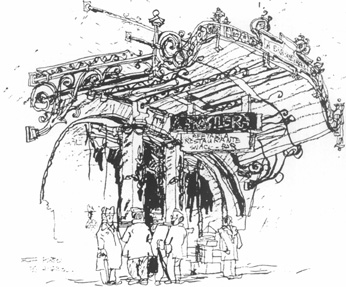
"A Brasileira" Care (drawing by Ung Vai Meng).
Translated by Marie Imelda MacLeod
start p. 133
end p.